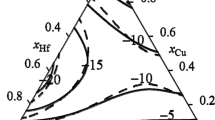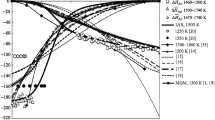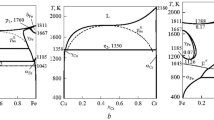Theoretical bases for the calculation of metastable phase transformations with the participation of supercooled multicomponent melts in the framework of the CALPHAD method are considered. A database with parameters for models of thermodynamic properties of phases in the Cu–Ni–Ti–Zr–Hf system for such calculations is presented. The excess term of the Gibbs energy of liquid alloys is described using the associated solution model, and bcc and fcc solid solutions with a mathematical model with Redlich–Kister polynomials. The diagrams of metastable phase transformations with the participation of supercooled liquid alloys and boundary solid solutions are calculated. The composition ranges for obtaining rapidly quenched and bulk amorphous ternary, quaternary, and quinary alloys of the Cu–Ni–Ti–Zr–Hf system are theoretically assessed.






Similar content being viewed by others
References
A. Inoue, F. L. Kong, S. L. Zhu, et al., “Production methods and properties of engineering glassy alloys and composites,” Intermetallics, 58, 20–30 (2015).
A. Inoue, F. L. Kong, S. L. Zhu, et al., “Peculiarities and usefulness of multicomponent bulk metallic alloys,” J. Alloys Compd., 707, 12–19 (2017).
R. B. Schwarz, P. Nash, and D. Turnbull, “The use of thermodynamic models in the prediction of the glass-forming range of binary alloys,” J. Mater. Res., 2, No. 4, 456–460 (1987).
R. Bormann, F. Gärtner, and K. Zöltzer, “Application of the CALPHAD method for the prediction of amorphous phase formation,” J. Less-Common Met., 145, 19–29 (1988).
N. Saunders and A. P. Miodownik, “Free energy criteria for glass forming alloys,” Ber. Bunsen Ges. Phys. Chem., 87, No. 9, 830–834 (1983).
P. G. Agraval, L. A. Dreval, and M. A. Turchanin, “Interaction of components in Cu–Fe glass-forming melts with titanium, zirconium, and hafnium. III. Modeling of metastable phase transformations with participation of liquid phase,” Powder Metall. Met. Ceram., 56, No. 7–8, 463–472 (2017).
A. T. Dinsdale, “SGTE data for pure elements,” CALPHAD, 15, No. 4, 317–425 (1991).
P. G. Agraval, L. A. Dreval, and M. A. Turchanin, “Interaction of components in Cu–Fe glass-forming melts with titanium, zirconium, and hafnium. II. Modeling of metastable phase transformations with participation of liquid phase,” Powder Metall. Met. Ceram., 56, No. 5–6, 323–332 (2017).
M. A. Turchanin, P. G. Agraval, and A. R. Abdulov, “Phase equilibria and thermodynamics of binary copper systems with 3d-metals. VI. Copper–nickel system,” Powder Metall. Met. Ceram., 46, No. 9–10, 467–477 (2007).
M. A. Turchanin, P. G. Agraval, and A. R. Abdulov, “Thermodynamic assessment of the Cu–Ti–Zr system. I. Cu–Ti system,” Powder Metall. Met. Ceram., 47, No. 5–6, 344–360 (2008).
M. A. Turchanin, P. G. Agraval, and A. R. Abdulov, “Thermodynamic assessment of the Cu–Ti–Zr system. II. Cu–Zr and Ti–Zr systems,” Powder Metall. Met. Ceram., 47, No. 7–8, 428–511 (2008).
M. A. Turchanin and P. G. Agraval, “Thermodynamic assessment of the copper–hafnium system,” Powder Metall. Met. Ceram., 47, No. 3–4, 223–233 (2008).
P. G. Agraval, A. R. Abdulov, L. A. Dreval, et al., “Thermodynamic modeling of stable and metastable transformations in the Ni–Ti system,” Vestnik DGMA, 25, No. 4, 6–13 (2011).
M. A. Turchanin and P. G. Agraval, “Calculation of metastable phase equilibria with participation of supercooled liquid and assessment of glass formation composition range in the (Co, Ni, Cu)–IVA-metal melts,” in: Physical Chemistry of Condensed Systems and Interfaces (Collected Scientific Papers) [in Ukrainian], Kyiv Universytet, Kyiv (2003), pp. 134–141.
H. Bittermann and P. Rogl, “Critical assessment and thermodynamic calculation of the ternary system boron–hafnium–titanium (B–Hf–Ti),” J. Phase Equilib., 18, No. 1, 24–47 (1997).
H. Bittermann and P. Rogl, “Critical assessment and thermodynamic calculation of the ternary system C–Hf–Zr (carbon–zirconium–hafnium),” J. Phase Equilib., 23, No. 3, 218–235 (2002).
M. A. Turchanin, T. Ya. Velikanova, P. G. Agraval, et al., “Thermodynamic assessment of the Cu–Ti–Zr system. III. Cu–Ti–Zr system,” Powder Metall. Met. Ceram., 47, No. 9–10, 586–606 (2008).
A. A. Vodopyanova, P. G. Agraval, M. A. Turchanin, et al., “Thermodynamic properties of liquid alloys in the Cu–Ni–(Ti, Zr, Hf) systems,” in: A. M. Fesenko and M. A. Turchanin (eds.), Proc. 6th Int. Sci. Conf. Advanced Technologies, Materials, and Equipment in Foundry (September 25–28, 2017) [in Ukrainian], DDMA, Kramatorsk (2017), pp. 39–40.
A. A. Vodopyanova, L. A. Dreval, P. G. Agraval, et al., “Investigation of the components interaction in the liquid glass-forming Ni–Ti–Hf alloys,” in: Proc. 18th Int. Sci. Conf. New Technologies and Achievements in Metallurgy, Material Engineering, and Production Engineering (May 31–June 2, 2017, Częstochowa, Poland), Series Monografie No. 68, Vol. 1, pp. 88–91.
M. Sakata, N. Cowlam, and H. A. Davies, “Chemical short-range order in liquid and amorphous 66:34 copper–titanium alloys,” J. Phys. F: Met. Phys., 11, No. 7, L157–L162 (1981).
C.-H. Hwang, Y.-J. Ryeom, and K. Cho, “Electrical resistivity and crystallization of amorphous Cu–Ti alloys,” J. Less-Common Met., 86, 187–194 (1982).
K. H. J. Buschow, “Effect of short-range ordering on the thermal stability of amorphous titanium-copper alloys,” Scr. Metall., 17, No. 9, 1135–1139 (1983).
J. Reeve, G. P. Gregan, and H. A. Davies, “Glass forming ability studies in the copper–titanium system,” in: Proc. 5th Int. Conf. Rapidly Quenched Metals, Meeting Date 1984, North-Holland, Amsterdam (1985), Vol. 1, pp. 203–206.
C. G. Woychik, D. H. Lowndes, and T. B. Massalski, “Solidification structures in melt-spun and pulsed laser-quenched copper–titanium alloys,” Acta Metall., 33, No. 10, 1861–1871 (1985).
C. Colinet, A. Pasturel, and K. Buschow, “Enthalpies of formation of Ti–Cu intermetallic and amorphous phases,” J. Alloys Compd., 247, No. 1, 15 (1997).
R. Ristić, E. Babić, D. Pajić, et al., “Properties and atomic structure of amorphous early transition metals,” J. Alloys Compd., 504, S194–S197 (2010).
K. H. J. Buschow, “Thermal stability of amorphous Zr–Cu alloys,” J. Appl. Phys., 52, 3319–3323 (1981).
I. Ansara, A. Pasturel, and K. H. J. Buschow, “Enthalpy effects in amorphous alloys and intermetallic compounds in the system Zr–Cu,” Phys. Status Solidi A, 69, No. 2, 447–453 (1982).
E. Kneller, Y. Khan, and U. Gorres, “The alloy system copper–zirconium. Part II. Crystallization of the glasses from Cu70Zr30 to Cu26Zr74,” Z. Metallkd., 77, 152–163 (1986).
A. Inoue and W. Zhang, “Formation, thermal stability, and mechanical properties of Cu–Zr and Cu–Hf binary glassy alloy rods,” Mater. Trans., 45, No. 2, 584–587 (2004).
D. Xu, B. Lohwongwatana, G. Duan, et al., “Bulk metallic glass formation in binary Cu-rich alloy series– Cu100−xZrx (x = 34, 36, 38.2, 40 at.%) and mechanical properties of bulk Cu64Zr36 glass,” Acta Mater., 52, No. 9, 2621–2624 (2004).
S.-W. Lee, M.-Y. Huh, E. Fleury, et al., “Crystallization-induced plasticity of Cu–Zr containing bulk amorphous alloys,” Acta Mater., 54, No. 2, 349–355 (2006).
L. Ge, X. Hui, G. Chen, et al., “Prediction of the glass-forming ability of Cu–Zr binary alloys,” Acta Phys. Chim. Sin., 23, No. 6, 895–899 (2007).
B. F. Lu, J. F. Li, L.T. Kong, et al., “Correlation between mechanical behavior and glass forming ability of Zr–Cu metallic glasses,” Intermetallics, 19, No. 7, 1032–1035 (2011).
T. Shindo, Y. Waseda, and A. Inoue, “Prediction of critical compositions for bulk glass formation in La-based, Cu-based, and Zr-based ternary alloys,” Mater. Trans., JIM, 44, No. 3, 351–357 (2003).
A. Inoue, W. Zhang, T. Zhang, et al., “High-strength Cu-based bulk glassy alloys in Cu–Zr–Ti and Cu–Hf–Ti ternary systems,” Acta Mater., 49, 2645–2652 (2001).
H. Men, S. J. Pang, and T. Zhang, “Glass-forming ability and mechanical properties of Cu50Zr50–xTi x alloys,” Mater. Sci. Eng. A, 408, No. 1, 326–329 (2005).
Q. Wang, J. Qiang, Y. Wang, et al., “Bulk metallic glass formation in Cu–Zr–Ti ternary system,” J. Non-Cryst. Solids, 353, No. 32, 3425–3428 (2007).
R. Bormann, F. Gärtner, and K. Zöltzer, “Application of the CALPHAD method for the prediction of amorphous phase formation,” J. Less-Common Met., 145, 19–29 (1988).
T. Zhang, A. Inoue, and T. Masumoto, “Amorphous (Ti, Zr, Hf)–Ni–Cu ternary alloys with a wide supercooled liquid region,” Mater. Sci. Eng. A, 181–182, 1423–1426 (1994).
A. Takeuchi and A. Inoue, “Calculations of amorphous-forming composition range for ternary alloy systems and analyses of stabilization of amorphous phase and amorphous-forming ability,” Mater. Trans., 42, No. 7, 1435–1444 (2001).
M. Fukuhara, M. Takahashi, Y. Kawazoe, et al., “Role of valence electrons for formation of glassy alloys,” J. Alloys Compd., 483, No. 1–2, 623–626 (2009).
K. H. J. Buschow and N. M. Beekmans, “Thermal stability of amorphous alloys,” Solid State Commun., 35, No. 3, 233–236 (1980).
G. Duan, D. Xu, and W. L. Johnson, “High copper content bulk glass formation in bimetallic Cu–Hf system,” Metall. Mater. Trans. A, 36, No. 2, 455–458 (2005).
J. Basu and S. Ranganathan, “Glass forming ability and stability: Ternary Cu bearing Ti, Zr, Hf alloys,” Intermetallics, 17, No. 3, 128–135 (2009).
Z. Altounian, E. Batalla, and J. Strom-Olsen, “Crystallization characteristics of late transition metal-Zr glasses around the composition M90Zr10,” J. Appl. Phys., 59, No. 7, 2364–2367 (1986).
K. Russew, F. Sommer, P. Duhaj, et al., “Viscous flow behavior of Ni x Zr100–x metallic glasses from Ni30Zr70 to Ni64Zr36,” J. Mater. Sci., 27, No. 13, 3565–3569 (1992).
A. Turchanin, M. Turchanin, and I. Tomilin, “Enthalpy of formation of amorphous and liquid nickel-zirconium alloys,” Mater. Sci. Forum, Trans. Tech. Publ., 269, 571–576 (1998).
X. J. Liu, X. D. Hui, G. L. Chen, et al., “Local atomic structures in Zr–Ni metallic glasses,” Phys. Lett. A, 373, No. 29, 2488–2493 (2009).
V. V. Molokanov, V. N. Chebotnikov, and Yu. K. Kovneristy, “Structure and properties of amorphous and crystalline alloys in the Ti2Ni–Zr2Ni section in the Ti–Ni–Zr system,” Neorg. Mater., 25, No. 1, 61–65 (1989).
X. J. Liu, X. D. Hui, and G. L. Cheng, “Thermodynamic calculation and experimental investigation of glass formation in Zr–Ni–Ti alloy system,” Intermetallics, 16, 262–266 (2008).
P. J. McCluskey and J. J. Vlassak, “Glass transition and crystallization of amorphous Ni–Ti–Zr thin films by combinatorial nano-calorimetry,” Scr. Mater., 64, No. 3, 264–267 (2011).
K. H. J. Buschow, “Short-range order and thermal stability in amorphous alloys,” J. Phys. F: Met. Phys., 14, No. 3, 593 (1984).
J. Basu and S. Ranganathan, “Glass-forming ability and stability of ternary Ni-early transition metal (Ti/Zr/Hf) alloys,” Acta Mater., 56, No. 8, 1899–1907 (2008).
I. Figueroa, H. Davies, and I. Todd, “Formation of Cu–Hf–Ti bulk metallic glasses,” J. Alloys Compd., 434, 164–166 (2007).
H. Choi-Yim and R. Conner, “Amorphous alloys in the Cu–Hf–Ti system,” J. Alloys Compd., 459, No. 1, 160–162 (2008).
J. Freitag, H. Guo, and Z. Altounian, “Transport properties of isostructural Ni–Zr–Hf metallic glasses,” Mater. Sci. Eng. A, 226, 1042–1044 (1997).
S. Hara, H. X. Huang, M. Ishitsuka, et al., “Hydrogen solution properties in a series of amorphous Zr–Hf–Ni alloys at elevated temperatures,” J. Alloys Compd., 458, No. 1, 307–312 (2008).
X. F. Wu, Z. Y. Suo, Y. Si, et al., “Bulk metallic glass formation in a ternary Ti–Cu–Ni alloy system,” J. Alloys Compd., 452, No. 2, 268–272 (2008).
H. Yang, J. Wang, and Y. Li, “Glass formation in the ternary Zr–Zr2Cu–Zr2Ni system,” J. Non-Cryst. Solids, 352, No. 8, 832–836 (2006).
K. Fujita, A. Okamoto, N. Nishiyama, et al., “Effects of loading rates, notch root radius and specimen thickness on fracture toughness in bulk metallic glasses,” J. Alloys Compd., 434, 22–27 (2007).
L. Ma, L. Wang, T. Zhang, et al., “Bulk glass formation of Ti–Zr–Hf–Cu–M (M = Fe, Co, Ni) alloys,” Mater. Trans., 43, No. 2, 277–280 (2002).
Author information
Authors and Affiliations
Corresponding author
Additional information
Translated from Poroshkova Metallurgiya, Vol. 57, Nos. 1–2 (519), pp. 75–98, 2018.
Rights and permissions
About this article
Cite this article
Turchanin, M.A., Agraval, P.G., Velikanova, T.Y. et al. Predicting the Composition Ranges of Amorphization for Multicomponent Melts in the Framework of the Calphad Method. Powder Metall Met Ceram 57, 57–70 (2018). https://doi.org/10.1007/s11106-018-9955-3
Received:
Published:
Issue Date:
DOI: https://doi.org/10.1007/s11106-018-9955-3




